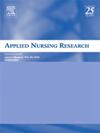Longitudinal analysis of adolescents at high risk of depression: Prediction models
IF 2.2
4区 医学
Q1 NURSING
引用次数: 0
Abstract
Background
This study aimed to develop a machine-learning-based predictive model to identify adolescents at high risk of depression using longitudinal analysis to determine changes in risk factors over time.
Methods
This longitudinal study used 4 years of data from the Korea Child and Youth Panel Survey (2018–2021). The classification of high-risk depression was the outcome variable, with predictors categorized into general characteristics and personal, family, and school factors. The machine learning algorithms used in the analysis included logistic regression, support vector machine, decision tree, random forest, and extreme gradient boosting.
Results
Among the 1833 adolescents classified as having a low risk of depression during the initial survey year, 27.8 % were identified as being at a high risk of depression over the subsequent 3 years. The extreme gradient boosting algorithm yielded the best performance with an area under the curve of 0.9302. The key predictors identified included violent tendencies, self-esteem, sleep duration, gender, and coercive parenting style.
Conclusion
A machine-learning-based predictive model for identifying adolescents at high risk of depression was developed. These findings provide a foundation for early screening and the development of intervention programs and policies aimed at mitigating adolescent depression risk.
青少年抑郁症高风险的纵向分析:预测模型
本研究旨在开发一种基于机器学习的预测模型,通过纵向分析来确定风险因素随时间的变化,以识别抑郁症高风险的青少年。方法本纵向研究使用了韩国儿童和青年小组调查(2018-2021)的4年数据。高危抑郁症的分类是结果变量,预测因子分为一般特征、个人、家庭和学校因素。分析中使用的机器学习算法包括逻辑回归、支持向量机、决策树、随机森林和极端梯度增强。结果在1833名在最初调查年度被归类为抑郁低风险的青少年中,27.8%的人在随后的3年中被确定为抑郁高风险。极值梯度增强算法的性能最好,曲线下面积为0.9302。确定的关键预测因素包括暴力倾向、自尊、睡眠时间、性别和强制性育儿方式。结论建立了基于机器学习的青少年抑郁高危人群预测模型。这些发现为早期筛查和制定旨在减轻青少年抑郁风险的干预计划和政策提供了基础。
本文章由计算机程序翻译,如有差异,请以英文原文为准。
求助全文
约1分钟内获得全文
求助全文
来源期刊

Applied Nursing Research
医学-护理
CiteScore
4.50
自引率
0.00%
发文量
65
审稿时长
70 days
期刊介绍:
Applied Nursing Research presents original, peer-reviewed research findings clearly and directly for clinical applications in all nursing specialties. Regular features include "Ask the Experts," research briefs, clinical methods, book reviews, news and announcements, and an editorial section. Applied Nursing Research covers such areas as pain management, patient education, discharge planning, nursing diagnosis, job stress in nursing, nursing influence on length of hospital stay, and nurse/physician collaboration.
 求助内容:
求助内容: 应助结果提醒方式:
应助结果提醒方式:


